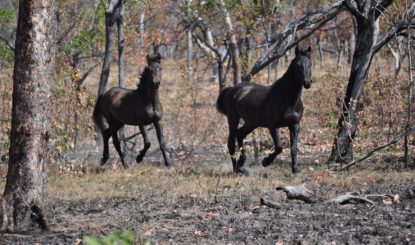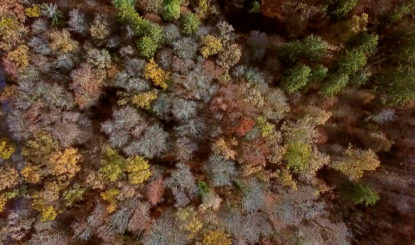Australia is Burning, But the Franz Weber Territory is Lush and Green
For 30 years, the Wild Horse Sanctuary “Bonrook” just outside of Pine Creek in the Northern Territory, Australia has been a paradise for wild horses and retired riding horses. Viktoria Kirchhoff recently visited the legendary “Franz Weber Territory” and describes her impressions here.
After a 2.5-hour drive south from Darwin on the Stuart Highway, shortly after the small town of Pine Creek, I turn left. I am welcomed by four beautiful horses, two of them enjoying a cool down in the creek. They are very trusting and immediately come up to my car to greet me. Their coats are shiny and they are well fed. As they are very tame, I quickly realise that they cannot be Brumbies, but must be the retired riding horses from the Franz Weber Territory. I come directly from Sydney, which is a 4.5-hour flight southeast of Darwin. For months we have had off and on days of thick smoke from the nearby fires that have brutally swept through the states of Queensland, New South Wales and Victoria. It’s wonderful to see the rainy season here in the north of the country and everything being lush and green.
As I walk across the footbridge of Bonrook Creek, Sam, the Station Manager of Bonrook, and his three dogs Momo, Hendo and Luna welcome me warmly into their home. The next morning, we start at 7:30 AM: Sam and I drive into the bush on the two quads. We drive through tall, lush grass, scrub, trees, bumpy paths, stones and streams. Sam tells me that normally you don’t see brumbies or other animals during the rainy season because the grass is so tall, the bush is very dense and there are waterholes and filled billabongs all over the 500 km2 (18 km by 28 km) Bonrook area, so the wild horses can spread out. But we are lucky: after only 40 minutes we see a mob of about 15 brumbies galloping 150 metres parallel to our left! “This is an exceptionally large mob, normally they are only about 7-8 horses in size. This indicates a strong alpha stallion that manages to keep such a large group together,” Sam says.
Cherished and cared for
I am amazed at how one single man can run and manage such a large area on his own. Sam laughs and says, “I never get bored, I love my job. There is no routine; every day is different.” Sam’s work is very varied and demands many different skills. For example, he checks and repairs fences, observes the brumbies, checks the horses’ water tanks, places salt stones for the brumbies at various water points, maintains and repairs all the vehicles and machinery, cuts the grass, trims trees around the homestead, works on the old hotel buildings and does fire risk management.
Until 2008, there was a hotel operating on Bonrook. However, as tourism in the state of Northern Territory declined, and insurance costs for hotel operations skyrocketed, the FFW decided in 2008 to focus its work entirely on nurturing and caring for the Brumbies and retired riding horses, and closed the hotel.
Wonderful flora and fauna
Bright green grass everywhere I look. Sam explains, “All lands in the Northern Territory are inspected every three years by a government agency.” They check the condition and quality of the meadows, grasses and soil. The last inspection on Bonrook was in August 2019: 16 different areas of 50 metres radius were tested. The finding: “Good” – an excellent result for an area inhabited by wildlife.
Although Sam tells me that “in the middle of the year, during the dry season, we have a greater variety of birds here”, I see and hear countless birds, such as cockatoos, galahs, pheasant coucals, plovers, white ibises and brolgas. While exploring the south-western part of the Franz Weber Territory on the second day, I discover something very special by the wayside: the wonderful nest of a great bowerbird, built with much love and skill from carefully selected branches. The entrances carefully decorated with a white carpet of hundreds of snail shells and coloured glass shards– this is how the male tries to attract a mate. Thanks to its exceptionally clever nest-building skills, the great bowerbird is considered one of the most intelligent birds.
Always one step ahead of the fire
The devastating fires in the south-east of Australia do not directly affect Sam and Bonrook. Nevertheless, he deals with the issue seriously; he discusses it at meetings with neighbours, indigenous groups and the local fire brigade. As vice-captain of the local volunteer fire brigade, Sam has an excellent knowledge of bushfire risk, control and management. “Fire risk management needs to be done continuously throughout the whole year. The key is to stay ahead of the fire, always be proactive and well-prepared,” Sam says.
After four days, my visit has come to an end. I am happy to see how well the animals and nature are doing on Bonrook and can now return to a smoke-free Sydney after several days of rain in the south of the country.
More information:
- Our project page “Wild Horse Sanctuary in Australia”
- This article was first published in the Journal Franz Weber 131. You can find the PDF version of all previous magazines here.
- You have not yet subscribed to our quarterly magazine, the Journal Franz Weber? Order the latest issue for free here (in German and French only).


